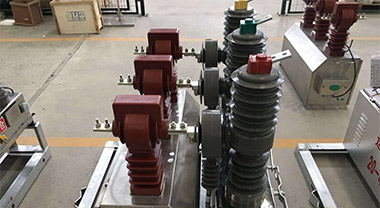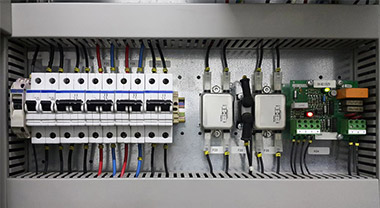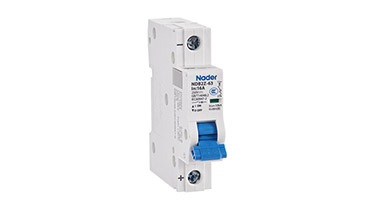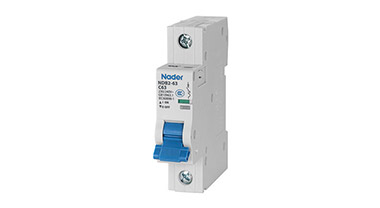How to maintain the oil circuit breaker?
Pay attention to the use of the oil circuit breaker during electrical operation, conduct regular inspections on it, and deal with the problems found in the inspection in a timely manner to keep the circuit breaker in good operating condition and ensure the safe operation of the system.
(1) The inspection of the position of the circuit breaker should not only be based on the indication of the closing mechanical position indicator, but also the state of the opening and closing springs and the changes in the position of the horizontal lever or outer arm of the transmission mechanism to confirm the opening and closing of the oil circuit breaker. Actual closing position.
(2) The oil level inspection should check the oil level of each fracture of the three-phase, and it should be between the upper and lower monitoring lines of the oil standard. Too high oil level may cause insufficient buffer space in the fuel tank, and the circuit breaker may spray oil during accident opening; too low oil level may cause the arc to rush out of the oil surface during accident opening, causing the circuit breaker to catch fire or even explode.
(3) Check the operating temperature to keep the operating temperature of the oil temperature, housing, and lead wires within the standard.
(4) The inspection of bushings and insulators should be free of cracks, breakages, discharge traces, discharge sound and corona sound.
(5) Inspection of the operating mechanism All parts of the operating mechanism should be intact, and the operating energy should be within the allowable operating range.
(6) Check whether the oil circuit breaker has oil leakage. The oil leakage of the oil circuit breaker is mainly at the joint of the gasket, the main shaft oil seal, the oil level gauge, and the oil drain valve. If oil leakage is found, the cause of the leakage should be analyzed and dealt with in time to ensure the safe and reliable operation of the oil circuit breaker. If the oil leakage is not handled in time, the oil level of the circuit breaker will be lowered, and insufficient oil will affect the breaking capacity. When a large amount of oil leaks, the circuit breaker is not allowed to open when there is a severe oil shortage or no oil. The dispatching transfer load should be reported immediately, and the bypass circuit breaker can be used to replace or disconnect the upper-level circuit breaker before processing.
(7) Check whether the oil level of the oil circuit breaker is within the specified range. The normal oil level of the oil circuit breaker in operation should be between the two oil level monitoring lines of the oil level gauge, and shall not be higher than the upper monitoring line or lower than the lower monitoring line. Exceeding the upper and lower monitoring lines will adversely affect the operation of the circuit breaker. If the oil level is too high, a large amount of gas may be decomposed due to the action of arc and oil when the fault circuit is cut off. If the pressure is too high, fuel injection may occur, and even the circuit breaker fuel tank may deform or explode due to the reduced buffer space. If the oil level is too low, the parts and even the arc extinguishing chamber will be exposed to the air, and the moisture in the air will enter the oil tank, which may cause the insulation to become damp. Moreover, due to the small amount of oil, the gas pressure is too low when the faulty circuit is opened and the arc extinguishing is difficult. , So that the arc burns out the contacts and the arc extinguishing chamber, and even the arc rushes out of the oil surface, ignites the combustible gas formed by the gas and air formed by the high temperature decomposition of the oil in the buffer space, causing an explosion. During the oil level check, you should carefully check the oil level gauge to prevent the oil level gauge from generating a "false oil level" due to poor oil flow. The change of the oil level of the oil circuit breaker is affected by the amount of oil in the circuit breaker and the temperature of the oil, and the oil temperature changes with changes in the environmental temperature and load. In addition, changes in the oil level are also related to water ingress and oil leakage in the circuit breaker. Therefore, when the oil level of the circuit breaker is too high or too low, a comprehensive judgment should be made, and then a decision is made whether to drain or supplement the oil.
(8) Check whether the oil color of the oil circuit breaker is normal. For the oil circuit breaker in operation, the normal oil color should be transparent and not black, and the new oil should be light yellow, and the color will become darker after a period of operation. The oil color cannot directly and accurately judge whether the oil quality is qualified, but the oil quality can be roughly judged according to the color, transparency, and odor of the oil in operation. If the oil color suddenly becomes darker, darker or dark brown in a short period of time, the oil should be sampled for testing, chemical analysis, and insulation test of the oil should be done at the same time, because this may be caused by the internal heating of the circuit breaker, acid reaction, and pressure resistance. Reduced.
(9) Check whether the temperature of the oil circuit breaker body and joints is overheated, whether the temperature-indicating wax sheet is melted, whether the color-changing paint is discolored, and whether there is a big difference between the casing temperature and the ambient temperature.
(10) Check whether the circuit breaker is flooded (especially in the rainy season). Outdoor circuit breakers are not tightly sealed due to oil tanks, flanges, welds, casings, etc., and water may be mixed in when it rains to increase the oil level and reduce the oil insulation strength. If water is found in the circuit breaker oil, it should be treated in time, and the water in the oil should be tested, and the pressure test of the oil should be done.
(11) Check the oil circuit breaker for abnormal sound, such as "squeaking" discharge sound or oil rolling sound inside the circuit breaker, whether there is discharge sound at porcelain sleeve and lead wire, etc., and judge whether there is any sound by sniffing Burnt smell.
(12) Check whether the porcelain insulation is intact, whether there is damage, cracks, serious contamination and discharge, and whether the circuit breaker body is clean and complete.
(13) Check whether the operating mechanism is normal, whether the mechanism box is closed well, and whether there is moisture inside.
(14) Check the indication of the position indicator, the status of the circuit breaker on the monitoring screen and the size of the load current, etc., to determine whether the position of the circuit breaker is consistent with the actual operation.




